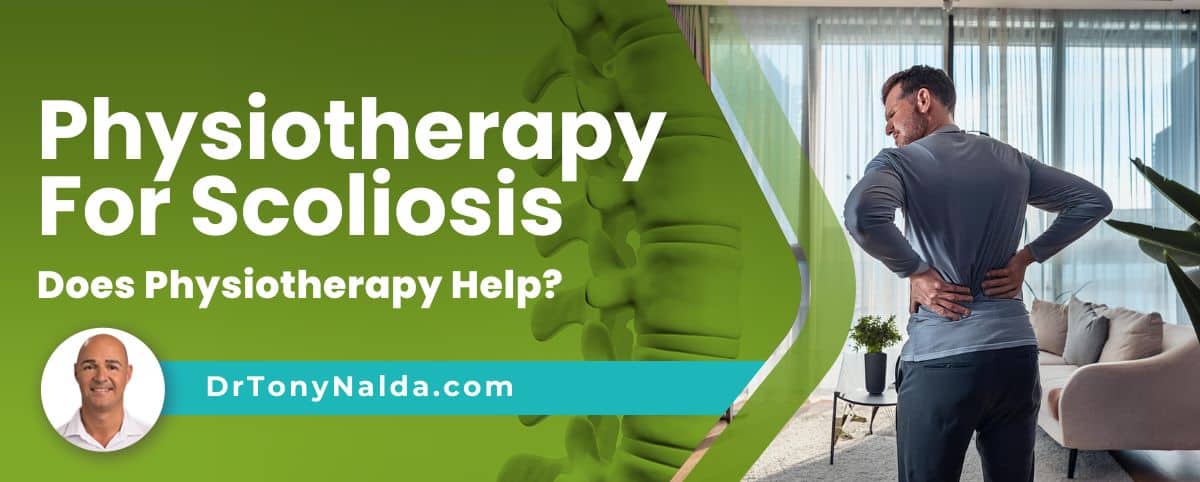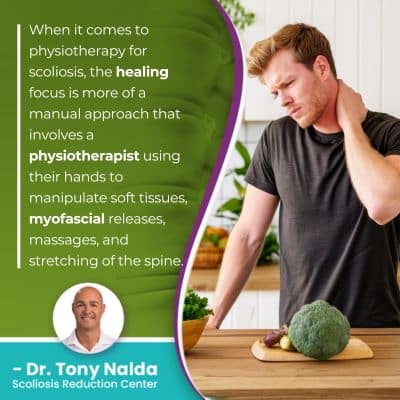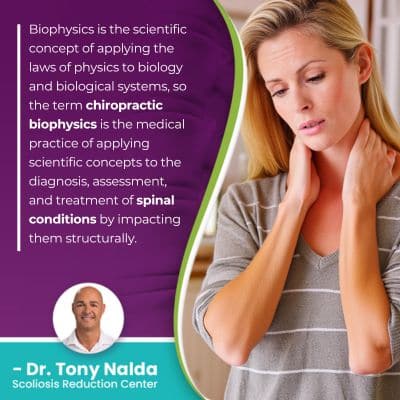Physiotherapy For Scoliosis: Does Physiotherapy Help?

Scoliosis is a structural spinal condition that involves the development of an unnatural sideways spinal curve that also rotates. There was a time when watching and waiting and surgery was the dominant treatment choice, but a modern corrective form of conservative treatment has evolved that's capable of addressing scoliosis while preserving long-term spinal health and function.
Physiotherapy for scoliosis focuses on restoring the spine's straight and neutral alignment through addressing muscle strength and symmetry, elongating the spine, and improving posture and postural awareness. When combined with chiropractic care, this is known as chiropractic biophysics.
When it comes to a nonsurgical response to treating scoliosis, a focus on the spine's surrounding muscles is key.
Table of Contents
What is Scoliosis?
While there are a number of spinal conditions that involve a loss of healthy spinal curves and alignment, scoliosis has some characteristics that set it apart from the rest, making it more complex to treat.
Scoliosis causes the development of an unnatural sideways-bending and rotating spinal curve, and the twist in the spine makes scoliosis a 3-dimensional condition.
In addition, the size of the curve has to be of a minimum size to be considered a true scoliosis: Cobb angle measurement of at least 10 degrees.
A patient's Cobb angle measurement is known as the gold standard in the diagnosis and assessment of scoliosis and is determined during X-ray.
A scoliosis X-ray is an essential part of the diagnostic process; it's used to see what's really happening in and around the spine, confirm a rotational component, and determine the Cobb angle.
A Cobb angle is a measurement that involves drawing lines from the tops and bottoms of the curve's most-tilted vertebrae at its apex, and the resulting angle is expressed in degrees.
The higher a Cobb angle, the more out of alignment the spine is, and the more severe the condition:
- Mild scoliosis is diagnosed with Cobb angle measurements of between 10 and 25 degrees
- Moderate scoliosis involves Cobb angle measurements of between 25 and 40 degrees
- Severe scoliosis is diagnosed with a Cobb angle of 40+ degrees, and very-severe scoliosis at 80+ degrees
It's very important to understand, however, that as a progressive condition, where a scoliosis is at the time of diagnosis isn't indicative of where it will stay; only proactive treatment can counteract the condition's progressive nature.
Understanding Scoliosis Treatment Options
There are two main ways to respond to a diagnosis of scoliosis, and as an incurable condition that can be highly manageable, this response will shape long-term spinal health and function.
A traditional response to a diagnosis of mild scoliosis would be the recommendation to simply watch and wait for signs of progression, but as a progressive condition, we know that virtually every case will get worse at some point, so to me, this is wasting valuable treatment time.
 Mild scoliosis is going to be the simplest to treat because the size of the unnatural spinal curve is small, and as significant progression hasn't yet occurred, the condition's effects are not yet well established.
Mild scoliosis is going to be the simplest to treat because the size of the unnatural spinal curve is small, and as significant progression hasn't yet occurred, the condition's effects are not yet well established.
Traditional scoliosis treatment doesn't have a strategy for addressing scoliosis while mild, so does little, other than traditional bracing, to attempt to prevent progression, and is more about responding to conditions with surgery once when/if they become severe and surgical candidates.
Scoliosis surgery is a type of spinal fusion that has the goal of stopping progression, and it works towards this goal by fusing the curve's most-tilted vertebrae into one solid bone so they can't become more tilted over time, and this is contrary to the spine's natural movement-based design.
Modern conservative scoliosis treatment offers a nonsurgical treatment alternative that wants to actually correct the structural condition and sustain results for optimal long-term spinal health.
Physiotherapy as Scoliosis Treatment
Physical therapy and physiotherapy have both commonalities and differences, and when it comes to scoliosis, the main difference is on the healing focus.
In physical therapy and scoliosis treatment, the focus is on how an exercise program can strengthen the spine's surrounding muscles for improved spinal support/stabilization, so physical therapy focuses more on an exercise-based approach to addressing muscular issues related to scoliosis.
Remember, it's not just the spine that has to maintain its natural curves and alignment, but also the work of the spine's surrounding muscles.
A spine that's supported and surrounded by a strong core is one that can function and maintain and also encourages postural awareness.
Scoliosis-specific exercises can also activate specific areas of the brain for improved brain-body communication and a healthier body positioning.
When it comes to physiotherapy for scoliosis, the healing focus is more of a manual approach that involves a physiotherapist using their hands to manipulate soft tissues, myofascial releases, massages, and stretching of the spine.
Gentle stretching of the spine can help counteract compression, and for adults, it's compression of the spine and its surrounding muscles and nerves that causes the majority of condition-related pain.
Part of myofascial therapy involves applying gentle pressure by hand to areas of the body that feel stiff and immovable, instead of flexible and elastic; these stiff areas surrounding the spine can limit muscle and joint movement, contributing to muscular issues, asymmetry, and pain.
So physiotherapy for scoliosis can help by determining areas surrounding the spine that are stiff and impairing joint movement, and working to release these areas to relax them and strengthen them can mean a spine that is supported and stabilized by strong surrounding muscles.
In addition, as scoliosis is known to cause the development of a muscular imbalance, physiotherapy that restores muscular symmetry means improvement to muscle strength, symmetry, pain, and spinal support.
As a complex structural spinal condition, no one form of treatment is enough to impact it on every level as it needs to be, and that includes both physical therapy and physiotherapy, but when combined with other types of treatment, like chiropractic care, corrective results can be worked towards.
Chiropractic Biophysics
 When biophysics is combined with condition-specific chiropractic care, this is known as chiropractic biophysics, and this is a scientific type of treatment approach that prioritizes spinal alignment by assigning geometric shapes to different types of spinal curvatures: a methodology that guides me in the crafting of customized treatment plans.
When biophysics is combined with condition-specific chiropractic care, this is known as chiropractic biophysics, and this is a scientific type of treatment approach that prioritizes spinal alignment by assigning geometric shapes to different types of spinal curvatures: a methodology that guides me in the crafting of customized treatment plans.
Chiropractic biophysics (CBP) is a concept of chiropractic that uses a scientific approach to address the importance of spinal alignment by assigning geometric shapes to spinal curvature characteristics; this is a methodology that helps me craft comprehensive and customized treatment plans.
Let's break down the term chiropractic biophysics further; chiropractic refers to a branch of medicine that focuses on the alignment of joints and joint movement, particularly in the spine.
As the brain and spine work in tandem to form the body's central nervous system, chiropractic care recognizes the widespread effects that spinal conditions can have throughout the body, and not just in and around the spine.
Biophysics is the scientific concept of applying the laws of physics to biology and biological systems, so the term chiropractic biophysics is the medical practice of applying scientific concepts to the diagnosis, assessment, and treatment of spinal conditions by impacting them structurally.
Conclusion
So can physiotherapy help with scoliosis? Yes, when combined with other forms of proactive treatment such as chiropractic care, it can help locate areas surrounding the spine that are so rigid they can affect joint movement and health within the spine.
Gentle by-hand manipulations of these areas can release stiff muscles for pain relief, and when combined with restoring muscular symmetry, this can mean a spine that's optimally supported and stabilized by healthy, strong, and balanced muscles.
When combined with condition-specific chiropractic care, physiotherapy for scoliosis is known as chiropractic biophysics and represents the union of manual vertebral adjustments with myofascial manipulations so stiff muscles and vertebral bodies are stretched, strengthened, and more movable.
The healthier the spine's surrounding muscles are, the healthier the spine is, and the easier it will be to maintain its natural and healthy curves and alignment.
Here at the Scoliosis Reduction Center, my treatment plans are fully customized, so no two are the same, and as I'm trained and certified in multiple different scoliosis-treatment modalities, including chiropractic biophysics, I can apportion these disciplines accordingly based on how the spine is responding.
When it comes to scoliosis treatment options, the most important aspect to understand is that while progressive, scoliosis can be highly treatable, and for those not wanting to passively observe while conditions progress and patients are funneled towards invasive spinal surgery, modern conservative treatment is integrative and effective.
Dr. Tony Nalda
DOCTOR OF CHIROPRACTIC
After receiving an undergraduate degree in psychology and his Doctorate of Chiropractic from Life University, Dr. Nalda settled in Celebration, Florida and proceeded to build one of Central Florida’s most successful chiropractic clinics.
His experience with patients suffering from scoliosis, and the confusion and frustration they faced, led him to seek a specialty in scoliosis care. In 2006 he completed his Intensive Care Certification from CLEAR Institute, a leading scoliosis educational and certification center.
About Dr. Tony Nalda
 Ready to explore scoliosis treatment? Contact Us Now
Ready to explore scoliosis treatment? Contact Us Now





